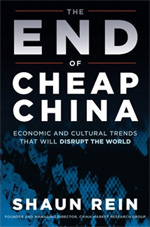‘The End of Cheap China’ – A Good Introduction to Understanding Today’s China Market
Op-Ed Commentary: Chris Devonshire-Ellis
 Apr. 18 – Amid the plethora of China books that are published each year, I only ever read a handful. The market is saturated with various perspectives, economic theories and political nuances in such numbers that only a crazy man could ever read them all and obtain a balanced view. Yet every once in a while, a book appears that makes you think “Yeah, I can buy into that.” Shaun Rein’s new book, “The End of Cheap China,” is such a volume.
Apr. 18 – Amid the plethora of China books that are published each year, I only ever read a handful. The market is saturated with various perspectives, economic theories and political nuances in such numbers that only a crazy man could ever read them all and obtain a balanced view. Yet every once in a while, a book appears that makes you think “Yeah, I can buy into that.” Shaun Rein’s new book, “The End of Cheap China,” is such a volume.
Unlike many of today’s China writers, Rein is the real deal. For a start, he set up and runs his own market research firm in China, and he lives in the country. Surprisingly few China commentators are actually based in China and even fewer face the responsibilities associated with running their own business. Rein does, and that marks his opinions out as possessing some merit. Forbes certainly thinks so – he has been a regular contributor to their online website for some time.
Rein’s thesis is that China is moving up the value chain and becoming wealthier, and he discusses the implications this has for global trade as well as the new opportunities and strategies that need to be deployed in China. His observations come from literally thousands of interviews he has conducted over the years with everyone from Chinese billionaires, factory workers, young mothers and even prostitutes, all sought out to extract some sense of China’s evolution: where it is headed and ultimately, what the modern Chinese consumer wants to buy and how they expect to be treated.
It is littered with anecdotes and some surprising statistics. I’ll list a handful that stood out for me:
- The average age of a Chinese Mercedes-Benz buyer being 39 as opposed to 53 in the United States
- The Chinese are buying their homes five years younger than their American counterparts on average
- Chinese meat consumption has shot up to half that of the United States
- Nearly 25 percent of China’s 1,000 wealthiest billionaires did so through real estate
- Healthcare and education are primary sources of concern for the mainland consumer
- Young Chinese women will often save up to three times their monthly salary to buy a luxury item such as a designer handbag
If I had a gripe about the book, it would be that not enough detail has gone into research ascertaining where the low-cost manufacturing base China had is now moving to, and the throw away premise that American consumers will (as a result of increasing Chinese labor costs) have to pay more for goods doesn’t quite ring true.
A couple of additional chapters to round the book off concerning the rise of ASEAN nations and India as inheriting Chinese population dividend and low-cost labor base would have provided a good ending for the book, although it’s also possible Rein has a sequel up his sleeve. But for a concise, entertaining and thoughtful look at where China is going, why, and some nicely laid out “Key Action Items” for erstwhile marketers to follow, Rein’s book does a good job. If there is one book you should read on an international flight heading for China – and especially for those businesses that are looking to sell to the Chinese – this is the volume you need.
- Previous Article 2012 Annual Compliance Reports for Shenzhen Representative Offices
- Next Article China’s Qualification Requirements for Legal Representatives and other Key Positions



























